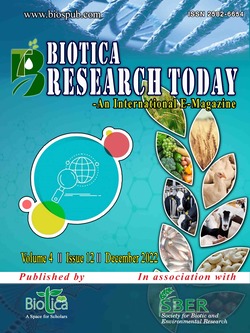
Alleviation of Hidden Hunger through Rice Biofortification
Pradip Kumar Saini
Dept. of Crop Physiology, Acharya Narendra Deva University of Agriculture & Technology, Kumarganj, Ayodhya, Uttar Pradesh (224 229), India
Shwetank Shukla
Dept. of Soil Science and Agricultural Chemistry, Acharya Narendra Deva University of Agriculture & Technology, Kumarganj, Ayodhya, Uttar Pradesh (224 229), India
Saurabh Singh
Dept. of Crop Physiology, Acharya Narendra Deva University of Agriculture & Technology, Kumarganj, Ayodhya, Uttar Pradesh (224 229), India
Jitender Bhati
Dept. of Seed Science and Technology, Acharya Narendra Deva University of Agriculture & Technology, Kumarganj, Ayodhya, Uttar Pradesh (224 229), India
Shambhoo Prasad*
Dept. of Plant Molecular Biology & Genetic Engineering, Acharya Narendra Deva University of Agriculture & Technology, Kumarganj, Ayodhya, Uttar Pradesh (224 229), India
DOI: NIL
Keywords: Biofortification, Fortification, Hidden hunger, Rice
Abstract
Rice (Oryza sativa L.), which is mostly consumed by individuals from various areas of Asia, is fed to more than half of the world's population. In rice, the transfer of micronutrients from the soil to the shoot and from the root to the shoot is regulated at several phases, including seed germination. Some of the effective efforts performed by numerous scientists to enhance the amount of micronutrients in rice include the use of phytose, ferritin protein storage by Fe, and increasing the content of genes encoding metal chelators (mostly phytosiderophores) and metal transporters. We are here for the article on rice biofortification to share the advances made in the goal of enriching rice with various micronutrient components such as Fe, Zn, and Mn as well as to lessen the widespread micronutrient insufficiency in humans.
Downloads
not found
Reference
Bhatnagar, M., Bhatnagar-mathur, P., Reddy, D.S., Anjaiah, V., Sharma, K.K., 2011. Crop biofortification through genetic engineering: Present status and future directions. Genomics and Crop Improvement: Relevance and Reservations 2(10), 392-407.
Cakmak, I., Kutman, U.B., 2018. Agronomic biofortification of cereals with zinc: a review. European Journal of Soil Science 69(1), 172-180. DOI: https://doi.org/10.1111/ejss.12437.
Chen, L., Yang, F., Xu, J., Hu, Y., Hu, Q., Zhang, Y., Pan, G., 2002. Determination of selenium concentration of rice in China and effect of fertilization of selenite and selenate on selenium content of rice. Journal of Agricultural and Food Chemistry 50(18), 5128-5130. DOI: https://doi.org/10.1021/jf0201374.
Darnton-Hill, I., Webb, P., Harvey, P.W.J., Hunt, J.M., Dalmiya, N., Chopra, M., Ball, M.J., Bloem, M.W., De Benoist, B., 2005. Micronutrient deficiencies and gender: Social and economic costs. American Journal of Clinical Nutrition 81(5), 1198-1205. DOI: https://doi.org/10.1093/ajcn/81.5.1198.
Dwyer, J.T., Wiemer, K.L., Dary, O., Keen, C.L., King, J.C., Miller, K.B., Philbert, M.A., Tarasuk, V., Taylor, C.L., Gaine, P.C., Jarvis, A.B., Bailey, R.L., 2015. Fortification and Health: Challenges and Opportunities 1(4), 124-131. DOI: https://doi.org/10.3945/an.114.007443.micronutrient.
